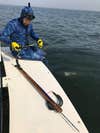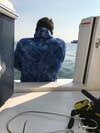Make a Stab: Spearfishing for Striped Bass in New York Harbor
We head out to the murky waters just off the coast of New York City with one of the regions most respected spearfishermen

Most days, you can see the Manhattan skyline in the distance as you leave Gateway Marina in Brooklyn, but today the smog is too thick. On this August morning, it’s hot and humid but the water is glass flat, as Yuri Krainov pilots his boat around Rockaway Inlet, passing Coney Island to our right, and cruises out into the Atlantic.
“The water clarity is actually pretty good right now,” Krainov says with a Russian accent. He moved from St. Petersburg, Russia, to the U.S. in 1991 in search of a better life—and he found one. After attending dentistry school at New York University, he became the successful proprietor of his own dental practice in Brooklyn. Because he generally works in the evenings when his patients have time to make appointments, he typically spends his mornings spearfishing.
For someone who’s about to plunge deep into murky water, he’s impressively calm. “The first five feet are no good,” he says, “but beneath that, the visibility is not too bad. You can see eight or nine feet in front of you, which is enough to see the fish.”
Krainov started out fishing with conventional gear, but ever since a friend showed him how to spearfish 12 years ago, it’s been his preferred method of fishing. Since then, he’s gone spearfishing in Florida and Mexico, and he’s now a mentor to a small, but tightly-knit community of spearfishermen in New York City. “When you’re conventional fishing, you just wait and see,” Krainov says. “If you’re lucky, you’re going to get something, but you don’t always know what you’re going to get. But when you’re spearfishing, you are actively diving and can choose which fish you shoot.”

At Rockaway Reef, Krainov drops a buoy where the fishfinder jags upward from the rocks. When he strays on his dives, he’ll be able to reorient himself after surfacing by using the buoy. It’s low tide, and there’s hardly any current, which is prime time for diving. Here, the shallowest point is 25 feet, and the ocean floor is 35 feet deep. Yesterday, the manmade reef, composed of steel buoys, concrete slabs, decking, and other industrial rubble, was what Krainov called a “parking lot of boats.” Today, there are only a few boats nearby.
Krainov dons his wetsuit, snorkel, and flippers. He grabs his long, wooden spear gun and slips into the water, where he loads the gun by drawing back two thick rubber cords and attaching them to notches on the back of the spear. Face-down, he breathes loudly through the snorkel for a few minutes, steadily pumping oxygen into his lungs. Then, in a sudden motion, he pivots, shooting his flippers up into the air as he drops beneath the surface.

The Depths
Before diving, Krainov told me about a friend of his who died while spearfishing six years ago off of Breezy Point, a popular spearfishing spot in Brooklyn. Yevgeniy Glebov was 29-years-old when his body, after four days of searching, was recovered by the Coast Guard. Though Krainov often fished with Glebov, he wasn’t fazed by his death.
“He was always very careless,” Krainov said. “He dove for a long time, and he thought he was invincible. He just went too far, probably. He liked to stay on the bottom for too long. He just overdid it.”
Krainov takes a no-nonsense approach to spearfishing—but that doesn’t mean he’s afraid to push his limits. He used to be a competitive free-diver, and after years of training in pools and the ocean, he reached his personal record of 200 feet below the surface. At that kind of depth, the pressure compresses your lungs to the size of an orange. These days, though, Krainov’s dives are far shallower. He resurfaces after approximately one-minute-long dives, removing his snorkel and gulping down air. When the water is clearer, in places like Florida, he’ll stay under for two to three minutes, but here, the low-visibility makes him wary. There’s an increased risk of being caught in fishing line or trapped against the rocks. And when you’re diving without oxygen, every second counts.
“If you stay calm, it’s usually not a problem,” he says. “You can figure out a way to cut the line or free yourself. But if you panic and move too fast, you waste oxygen.”
Then, there are the sharks. Spearing a fish leads to inadvertent chumming, and sharks can smell blood from hundreds of yards away. In Rockaway Reef, Krainov has only come face to face with a shark once; it was a great white and, though the shark ignored him, Krainov stopped diving for the rest of the day. But the next morning, he was back at it.
Despite these risks, Krainov finds sanctuary in the depths. “When I go in the water, I forget about all of my problems and concentrate only on diving,” Krainov says. “You feel totally free, which is probably why it’s called free-diving. You are weightless, like you are in space.”

No Shooters
Spearfishermen don’t have to worry about using the wrong lures or bait; they get what they can see. And today there aren’t any legal fish in sight, so after nearly 20 dives, Krainov calls it quits.
It’s early August, and during this time of year, Krainov generally targets striped bass, black seabass, fluke, porgy, and triggerfish. He saw a few small striped bass, but they were under the size limit. Besides the stripers, there is an abundance of blackfish, but state regulations prohibit shooting them until October 15—a date that Krainov anticipates in the same way other hunters anticipate opening day of deer season.
“Maybe this spot got overfished yesterday,” says Krainov, who’s still in a pretty good mood regardless of being shut out. Come winter, Krainov may take his boat South in search of Florida snapper and grouper, but for now, he’s still focused on his home turf. (Fishing at Rockaway Reef may improve in the near future, due to the recent announcement of the largest artificial reef expansion in New York state history.) Krainov tells me he’ll go spearfishing again later in the week, so if the fish are back in the rocks, he’ll be there to meet them, face-to-face.

For now, though, Krainov fires up the motor and points the bow back toward the smog.
